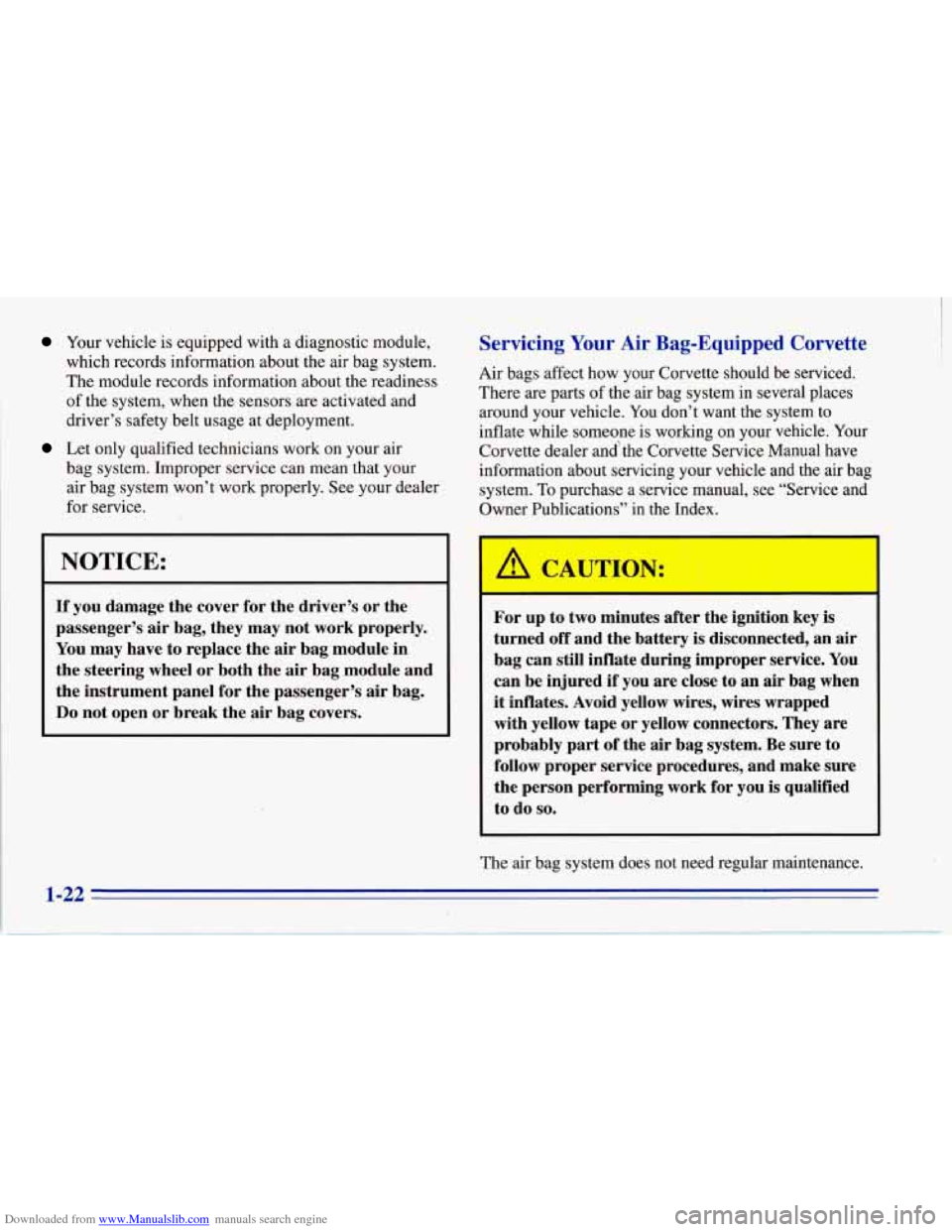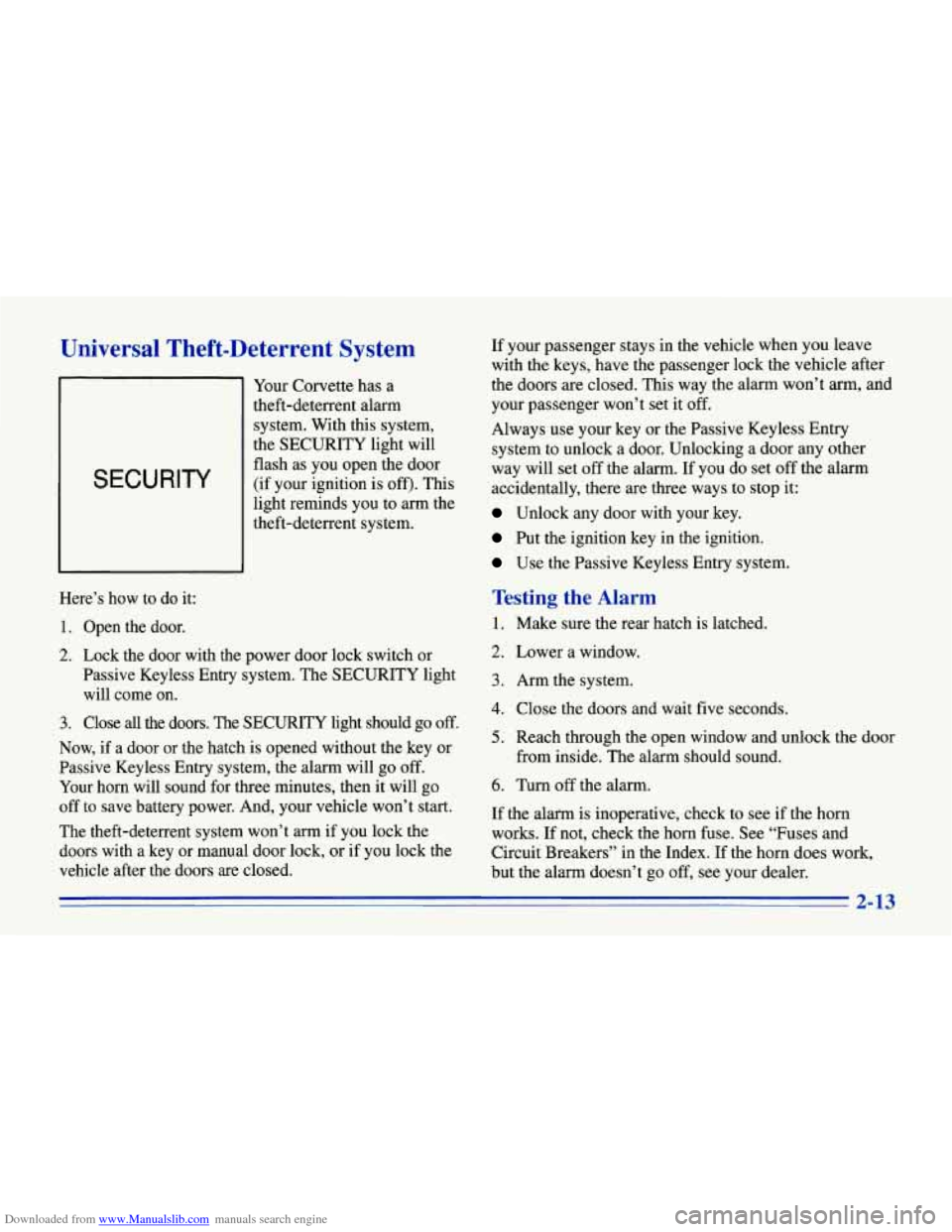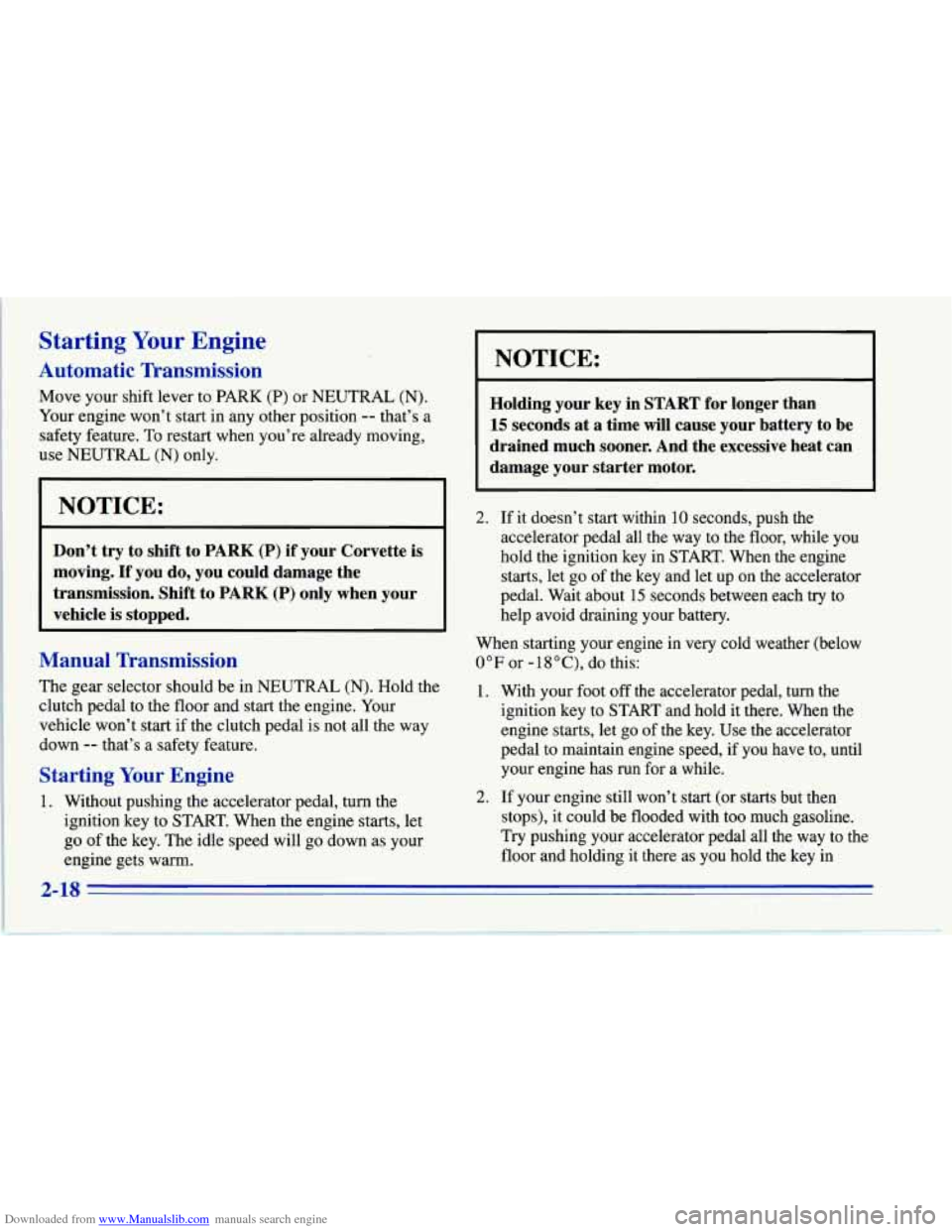1996 CHEVROLET CORVETTE key battery
[x] Cancel search: key batteryPage 33 of 386

Downloaded from www.Manualslib.com manuals search engine Your vehicle is equipped with a diagnostic module,
which records information about the air bag system.
The module records information about the readiness
of the system, when the sensors are activated and
driver’s safety belt usage at deployment.
Let only qualified technicians work on your air
bag system. Improper service can mean that your
air bag system won’t work properly. See your dealer
for service.
NOTICE:
If you damage the cover for the driver’s or the
passenger’s air bag, they may not work properly.
You may have to replace the air bag module in
the steering wheel or both the air bag module and
the instrument panel for the passenger’s air bag.
Do not open or break the air bag covers.
Servicing Your Air Bag-Equipped Corvette
Air bags affect how your Corvette should be serviced.
There are parts of the air bag system in several places
around your vehicle.
You don’t want the system to
inflate while someone is working on your vehicle. Your
Corvette dealer and‘the Corvette Service Manual have
information about servicing your vehicle and the air bag
system. To purchase a service manual, see “Service and
Owner Publications” in the Index.
For up to two minutes after the ignition key is
turned
off and the battery is disconnected, an air
bag can still inflate during improper service.
You
can be injured if you are close to an air bag when
it inflates. Avoid yellow wires, wires wrapped
with yellow tape or yellow connectors. They are
probably part of the air bag system. Be sure to
follow proper service procedures, and make sure
the person performing work for you is qualified
to do
so.
The air bag system does not need regular maintenance.
1-22
Page 48 of 386

Downloaded from www.Manualslib.com manuals search engine This device complies with Part 15 of the FCC Rules.
Operation is subject to the following two conditions:
(1) This device may not cause harmful interference, and
(2) This device must accept any interference received,
including interference that may cause undesired
operation.
Should interference to this system occur, try this:
0 Check to determine if battery replacement is
necessary. See the instructions on battery
replacement.
Check the distance. You may be too far from your
vehicle. This product has a maximum range.
Chkck the location. Other vehicles or objects may be
blocking the signal.
See your Chevrolet dealer or a qualified technician
for service.
Changes or modifications to this system by anyone other
than an authorized service facility could void
authorization to use this equipment.
Operation
You don’t have to do anything for PKE to work when
the passive feature is on. Just move toward your
vehicle with the
PKE transmitter, and the system will
automatically disarm your theft-deterrent system and
unlock the doors. If it’s dark enough outside, your
interior lamps will come on.
If you move out of range, the
PKE system will:
1. Lock the doors after five seconds.
2. Arm the theft-deterrent system.
3. Sound the horn to let you know the doors are locked.
4. Turn off the interior lamps.
You can also use the buttons on the transmitter. Press
DOOR to open the passenger’s door or HATCH to open
the hatch. The HATCH button will only work when the
ignition is off.
The system has a feature that makes it difficult for you
to lock your keys
in your vehicle. If you leave your keys
in the ignition and lock the doors,
the system will unlock
the doors as soon as they are closed. If you leave the
keys in the ignition-and move away with the transmitter,
the doors still will not lock. You should notice that the
horn doesn’t sound and return to get your keys.
Page 49 of 386

Downloaded from www.Manualslib.com manuals search engine The system will allow you to lock your keys in the
vehicle if you didn’t leave them in the ignition. You
should, however, be able to use the transmitter to get
them out. After
26 seconds of no motion, the transmitter
shuts down to save the battery. Wait about
30 seconds,
then rock the vehicle. The transmitter should “wake up”
and unlock the doors.
This system can’t guarantee that you’ll never be locked
out of your vehicle. If the battery is low or if the
transmitter is
in a place where the signal can’t get to the
antenna, it won’t unlock the doors. Always remember to
take your keys with you.
PKE Settings
You can use the system for both doors or just the
driver’s door, or you can turn the system off.
Changing the Door Settings
1. Put the ignition key in the ignition, but don’t turn it
on.
2. Press DOOR on the transmitter until the door locks
cycle (about two seconds).
II’urning the System Off
1. Take the ignition key out of the ignition.
2. Press DOOR on the transmitter until the door locks
cycle (about two seconds).
To turn the system back on,
just repeat the steps.
To check that the system is off, turn on the ignition. The
PASSIVE KEYLESS ENTRY light on the Driver
Information Center should not come on. If the light does
come on for a second or two, then the PKE system
is
still on.
You can also check whether the system is on or
off by
closing the door and moving away from the vehicle
with the keys and transmitter.
If the doors lock, the
system is on.
If you are working around your vehicle and keeping
your keys with you, you might want to turn the
PKE
system off. If you don’t, the transmitter will keep
locking and unlocking your doors.
2-6
~
Page 50 of 386

Downloaded from www.Manualslib.com manuals search engine TYPICAL RANGE
1 I
WA
( 1-1 'hm)
fl (1 'I2 5'-7' - 2m)
Transmitter Range
The transmitter range depends on your vehicle and where you are standing. The coupe
(A) has an antenna
in the driver's door and one in the rear area. The
convertible
(B) has one antenna in each door. The
antennas do not require any maintenance.
Range also depends on how you hold the transmitter.
For best performance, when you come near your vehicle, hold the transmitter straight up and down,
so the
keys hang down.
If the range seems to be decreasing, check the battery in
the transmitter. Range will decrease if the battery is low.
It will also decrease
if more than one transmitter is in
the area. Don't put the transmitter
in a metal container
because the transmitter won't work.
2-7
Page 51 of 386

Downloaded from www.Manualslib.com manuals search engine Matching Transmitter($) To Your Vehicle
Each key chain transmitter is coded to prevent another
transmitter from unlocking your vehicle. If a transmitter
is lost or stolen, a replacement can be purchased through
your dealer. Remember to bring any remaining
transmitters with you when you go to your dealer. When
the dealer matches the replacement transmitter to your
vehicle, any remaining transmitters must
also be
matched. Once the new transmitter is coded, the lost
transmitter will not unlock your vehicle. Each vehicle
can have only three transmitters matched to it.
To match transmitters to your vehicle:
1. Move all transmitters out of range.
2. Turn the ignition key on.
3. Push TRIP OD0 on the Driver Information Center
twice.
4. Within five seconds, press and hold FUEL INFO
until the PASSIVE KEYLESS ENTRY light
comes on.
5. Turn the ignition off, but leave the key in the
ignition. The PASSIVE KEYLESS ENTRY light
should begin to flash to show the system is in
programming mode.
6. Bring one transmitter into range. The light will stop
flashing and stay on to show that the code is stored.
7. Move the transmitter out of range. The light should
start flashing again.
8. Repeat Steps 6 and 7 with each additional
The programming mode will shut
off if
transmitter.
0 You
don’t program any transmitters for two minutes.
0 You take the key out of the ignition or turn the
ignition on.
0 You have programmed three transmitters.
Battery Replacement
Under normal use, the battery in your key chain
transmitter should last about
18 months.
You can tell the battery is weak if the transmitter won’t
work at the normal range in any location. If you have to
get close to your vehicle before the transmitter works,
it’s probably time to change the battery.
Page 53 of 386

Downloaded from www.Manualslib.com manuals search engine If you have a coupe, this
switch is on the rear
of the
driver’s door. It works with
the door open and the
transmission in any gear.
Push it down to release the
hatch.
The
PKE transmitter will also release the hatch. See
“Passive Keyless Entry System’’ in the Index.
8
I , .. .
If you don’t have battery power, use the manual release
cable to open the hatch. The cable
is near the security
shade handle, between the carpet and the shade.
2-10
Page 56 of 386

Downloaded from www.Manualslib.com manuals search engine Universal Theft-Deterrent System
SECURITY
Your Corvette has a
theft-deterrent alarm system. With this system,
the SECURITY light will
flash as you open the door
(if your ignition is off). This
light reminds you to arm the
theft-deterrent system.
Here’s how to do it:
1. Open the door.
2. Lock the door with the power door lock switch or
Passive Keyless Entry system. The SECURITY light
will come
on.
3. Close all the doors. The SECURITY light should go off.
Now, if a door or the hatch is opened without the key or
Passive Keyless Entry system, the alarm will
go off.
Your horn will sound for three minutes, then it will go
off to save battery power. And, your vehicle won’t start.
The theft-deterrent system won’t arm
if you lock the
doors with a key or manual door lock, or
if you lock the
vehicle after the doors are closed. If
your passenger stays in the vehcle when you leave
with the keys, have the passenger lock
the vehicle after
the doors
are closed. This way the alarm won’t arm, and
your passenger won’t set it off.
Always use your key
or the Passive Keyless Entry
system to unlock a door. Unlocking a door any other
way will set
off the alarm. If you do set off the alarm
accidentally, there
are three ways to stop it:
Unlock any door with your key.
Put the ignition key in the ignition.
Use the Passive Keyless Entry system.
Testing the Alarm
1.
2.
3.
4.
5.
6.
Make sure the rear hatch is latched.
Lower a window.
Arm the system.
Close the doors and wait five seconds.
Reach through the open window and unlock the door
from inside. The alarm should sound.
Turn
off the alarm.
If the alam is inoperative, check to see if the horn
works. If not, check the horn fuse. See “Fuses and
Circuit Breakers” in the Index. If the horn does work,
but the alarm doesn’t
go off, see your dealer.
2-13
Page 61 of 386

Downloaded from www.Manualslib.com manuals search engine Starting Your Engine
Automatic Transmission
Move your shift lever to PARK (P) or NEUTRAL (N).
Your engine won’t start in any other position
-- that’s a
safety feature. To restart when you’re already moving,
use NEUTRAL (N) only.
NOTICE:
Don’t try to shift to PARK (P) if your Corvette is
moving. If you do, you could damage the
transmission. Shift to PARK
(P) only when your
vehicle is stopped.
Manual Transmission
The gear selector should be in NEUTRAL. (N). Hold the
clutch pedal to
the floor and start the engine. Your
vehicle won’t start if the clutch pedal is not all the way
down
-- that’s a safety feature.
Starting Your Engine
1. Without pushing the accelerator pedal, turn the
ignition key to START. When the engine starts, let
go of the key. The idle speed will go down as your
engine gets warm.
NOTICE:
Holding your key in START for longer than
15 seconds at a time will cause your battery to be
drained much sooner. And the excessive heat can
damage your starter motor.
2. If it doesn’t start within 10 seconds, push the
accelerator pedal all the way to the floor, while you
hold the ignition key in START. When the engine
starts, let
go of the key and let up on the accelerator
pedal. Wait about
15 seconds between each try to
help avoid draining your battery.
When starting your engine in very cold weather (below
0°F or -18”C), do this:
1. With your foot
off the accelerator pedal, turn the
ignition key to START and hold it there. When the
engine starts, let
go of the key. Use the accelerator
pedal to maintain engine speed, if you have to, until
your engine has run for a while.
stops), it could be flooded with too much gasoline.
Try pushing your accelerator pedal all the way to the
floor and holding it there as you hold the key in
2. If your engine still won’t start (or starts but then
2-18